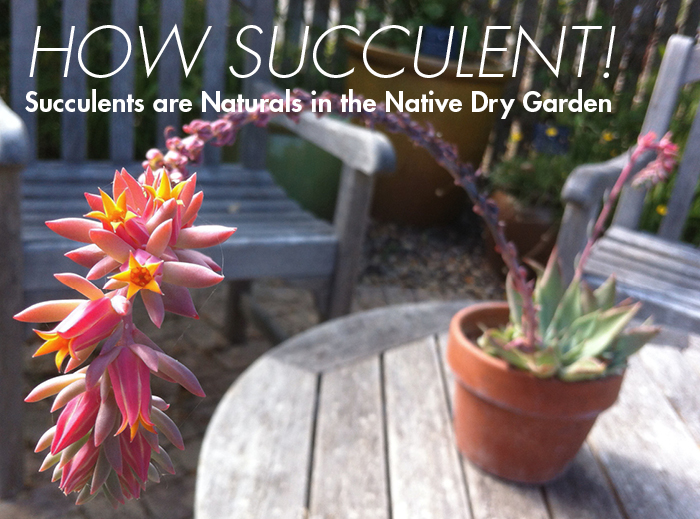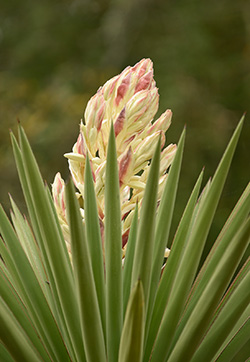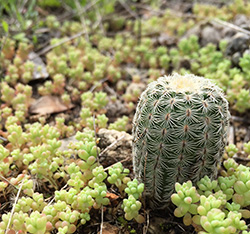
ANOTHER NATIVE PLANT GARDENING SECRET is out. Garden gurus have figured out that creating a succulent dry garden is simple given the availability of more and more native succulents from nurseries and botanic garden plant sales. Succulent borders, containers and walls are popping up all over, especially where water is scarce.
Julie Marcus, senior horticulturist at the Wildflower Center, says it was only a matter of time before these striking plants were given their due. “Native plant gardeners have been gardening with succulents for decades. Because the plants store water in their thicker than normal leaves or stems, they are ideal for dry climate gardens.”
Cacti may be the most well known of succulents, but there are plenty of others to choose from. Agave, yucca, hesperaloe and echeveria are just a few. Display one on its own in a large container or pair them with complementary plants that soften a succulent’s austere structure.

Yuccas make powerful focal pieces in the dry landscape. This Spanish dagger (Yucca treculeana) can be seen in the Wildflower Center’s color garden. Its height of 10 feet or more and 3-foot wide leaves turn heads, especially when it blooms flowers in dense showy clusters come spring. PHOTO Wildflower Center
Make them the focus
It’s easy to create a focal point in the garden with a large succulent plant. Marcus likes how Thompson’s yucca (Yucca thompsoniana) adds drama to a landscape. This one reaches 12 feet in its native Texas and stays tidy, unlike some other yuccas that can take on a shaggy appearance. Spanish bayonet (Yucca faxoniana) is smaller but still lends structure and form to a garden spot. Sotols like green sotol (Dasylirion leiophyllum) produces an unbranched flower stalk that gets five to 20 feet tall. In the eastern U.S. (even as far north as Wisconsin), look for a yucca called Adam’s needle (Yucca filamentosa).
Pair them well
Marcus thinks succulents look best when paired with other types of plants that offer complementary shape or texture. “We have a design at the Center that features Havard’s agave (Agave havardiana) surrounded by Mexican feathergrass (Nassella tenuissima). The contrast of just two species and soft versus hard was really effective,” she says. The Wildflower Center’s Family Garden combines the Havard’s agave with blue grama (Bouteloua gracilis) for the same effect. Marcus recommends silver plants such as silver ponyfoot (Dichondra argentea) or wooly stemodia (Stemodia lanata) to soften larger, spikey succulents.

In this Wildflower Center garden, yellow stonecrop (Sedum nuttallianum) surrounds lace cactus (Echinocereus reichenbachii). Because it forms mats, this sedum is an ideal groundcover. Its delicate yellow blooms add interest in spring and early summer. PHOTO Lee Clippard
Contain them
You’ll sometimes see succulents planted in colorful pots and placed in a garden bed. This approach lends a sense of whimsy to the dry garden. Succulents in general are well suited to containers since they tend to dry out. The echeveria, manfredas and the sedums are great container succulents, according to Marcus. She says Siler’s tuberose (Manfreda sileri) will even tolerate some light shade.
Cover the ground
Smaller succulents make unusual, eye-catching groundcovers. Yellow stonecrop (Sedum nuttallianum) is a delicate, sweet mat-forming annual that blooms small, yellow flowers with five sharp-pointed petals clustered along horizontal branches in spring and early summer. Like Siler’s tuberose, this one will take some shade. Another Manfreda, false aloe (Manfreda maculosa) gets only five to eight inches high and can act as a groundcover.
Succulent plants are gaining in popularity not just because they need little water. They are also easy to care for, and have even been called indestructible. But you should consider their need for good drainage at planting time. Marcus recommends planting up on a berm if you have clay soil. No matter what, it pays to add some decomposed granite to help aid proper drainage for your succulent plantings.

